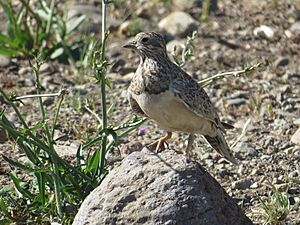Least seedsnipe facts for kids
Quick facts for kids Least seedsnipe |
|
|---|---|
 |
|
| Conservation status | |
| Scientific classification | |
| Genus: |
Thinocorus
|
| Species: |
rumicivorus
|
 |
|
The least seedsnipe (scientific name: Thinocorus rumicivorus) is a small, unique bird that loves dry places. It's part of the Thinocoridae family.
You can find these birds breeding in countries like Argentina, Bolivia, Chile, and Peru. They are quite common across South America. They've even been seen in Ecuador, the Falkland Islands, Uruguay, Brazil, and surprisingly, as far south as Antarctica! Their home range is huge, covering about 1.3 million square kilometers.
Contents
Where Does the Least Seedsnipe Live?
The least seedsnipe's natural habitats include grassy areas where the weather is mild, or high-up grasslands in warmer, tropical regions. They also live in pastures. But these birds are very adaptable! You might spot them in many different places, from sandy beaches to wide-open steppes (like flat, treeless plains). They can even survive in some open deserts in northern Chile.
What's in a Name?
The least seedsnipe got its name in 1829 from a scientist named Eschscholtz. The first part of its scientific name, Thinocorus, comes from Greek words meaning 'sand' or 'desert' and 'lark'. This makes sense because they live in dry, sandy places. The second part, rumicivorus, comes from Latin words meaning 'sorrel' (a type of plant) and 'eater'. This tells us a lot about what they like to eat!
What Does the Least Seedsnipe Look Like?
The least seedsnipe is the smallest bird in its family. They have short tails but long, pointed wings that help them fly. Their legs and toes are a dull greenish-yellow color. Their beak is a grayish color and is shaped like a cone, similar to the beaks of finches or sand grouse.
Adult male seedsnipes have a gray face, neck, and chest. They also have special black lines in the middle of their throat that look like an upside-down "T". Their eyes are a dark gray.
How Do Least Seedsnipes Behave?
Male seedsnipes like to sit on a tall bush or a fence post. From there, they make special calls to attract a mate. These calls sound like a quick "pu-pu-pu-pu-pu," which is very similar to the sound a Common Snipe makes.
These birds are super good at living in dry places. They don't lose much water from their bodies, even when it's hot. They can keep their body temperature stable in warm weather. They also have a slower metabolism than other birds their size. This means their bodies use less energy, which helps them stay cool and save water.
Reproduction and Nesting
Only the female least seedsnipe sits on the eggs to keep them warm. They usually lay four eggs in a simple nest on the ground. This nest is just a shallow dip in the dirt. When the female leaves the nest, she uses her feet to bury the eggs. This is different from some other birds that use their beaks. If there are loose, dry plants nearby, she will use them to cover her baby birds until she comes back. This behavior helps hide the eggs and chicks from animals that might want to eat them. It also helps keep the eggs and babies at a good temperature.
What Do Least Seedsnipes Eat?
As their name suggests, least seedsnipes mostly eat seeds. But they also enjoy eating leaves and buds from plants. So, they are strict vegetarians in the wild! However, if they are kept in a zoo, they have been known to eat mealworms.
Unlike most birds in their group, seedsnipes have a special stomach part called a crop. They also have a gizzard and long intestinal parts called caeca. These help them digest their plant-based diet. They often crouch down to eat, quickly biting off pieces of plants and swallowing them whole. They also stretch to nibble on the tops of grasses and tall plants. They get most, if not all, of the water they need from the juicy plants they eat. You will rarely see them drinking water. They have even been seen visiting a type of flower called Calceolaria uniflora. They feed on the soft parts of the flower's lower lip, and while doing so, they help the flowers by moving pollen from one flower to another.
Status and Conservation
The least seedsnipe lives in a very large area and is one of the most common birds in southern Patagonia. Scientists believe their population is stable, meaning their numbers are not going down. Because of this, the IUCN (International Union for Conservation of Nature) has listed them as a species of Least Concern. This means they are not currently in danger of disappearing.


